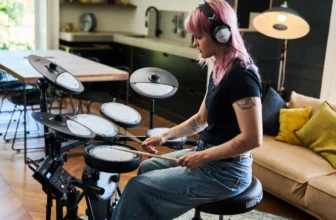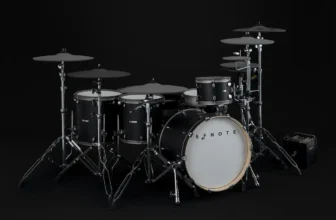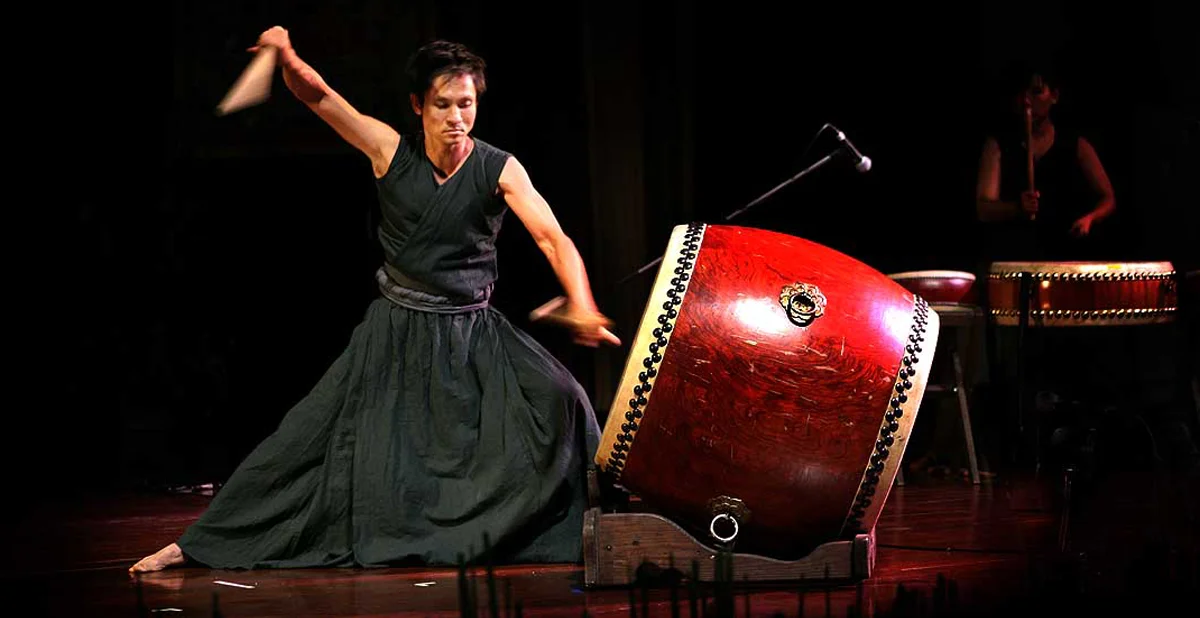

At my local university, the Japanese program had a Taiko club. In Japanese, the word taiko means “a drum.” Taiko is also known as kumi-daiko, which references the various drums that make up this percussion ensemble. Taiko drums are typically shaped like barrels and come in different sizes. Keep reading to learn more about this multi-faceted ensemble with ancient origins.
So What is Taiko Drumming, Exactly?
Taiko drumming is a type of athletic ensemble made up of drums called wadaiko. Taiko is also known as “The Japanese Art of Drumming.” Taiko drumming is exciting and vibrant. You can hear taiko globally, but it is most often performed in Japan, where it originated.
Taiko Drumming; Origins
Taiko has military origins, as this ensemble was used in arenas to communicate commands with Japanese soldiers. However, some music historians believe that taiko was invented in Korea or China, then came to Nihon (Japan). Others think it was the other way around.
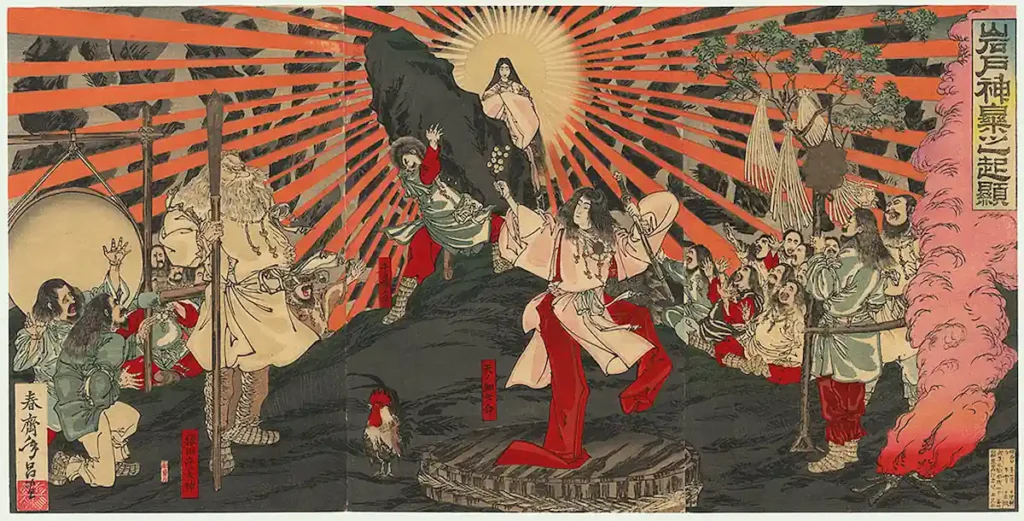
Taiko also has roots in Japanese mythology. It all began with the sun goddess Amaterasu Omikami, whose actions led to the creation of the ensemble. This story comes from the Nihon Shoki (also known as The Chronicles of Japan) and is considered one of Japan’s oldest historical texts.
Amaterasu Omikami hid in a cave and magically sealed herself because she was upset; people tried for days to get her out, but no one could succeed. Finally, a group of gods gathered and began making music outside the cave. It is said that the goddess of Ameno-uzume danced and that the rhythm of the goddess’s feet created taiko. The above depiction is Amartersu coming out of her cave.
Taiko has ties to the nature-based Japanese religion called Shinto as well. Some historians believe that taiko began with Shinto to communicate with the gods and ward off evil spirits. As taiko became more popular, Buddhists began to use the drums in their practice, such as during chants. Taiko drums are also used in Kabuki, a type of Japanese theater created during the Edo period.
The 4 Principals of Taiko
The four principles of taiko are:
- Ki
- Kata
- Technique
- Attitude
Ki means energy in Japanese and is synonymous with the Chinese term’ Qi,’ whereas Kata is meaningful movement. Taiko isn’t just about musicality—it is a full-body experience. When Ki, Kata, technique, and attitude are combined, it turns into something brilliant. We should all take a tip from taiko and integrate these four facets into our own performances and genre. According to San Jose Taiko, attitude is the most essential principle; everything else is secondary.
What Does Taiko Drumming Sound Like?
Taiko drumming sounds dramatic and thrilling and is full of yelling. It looks and sounds like a cross between a percussion ensemble and a form of martial arts. Taiko can be loud, dynamically speaking. The performances usually last around 2 hours. Some have likened the larger drums to the sound of thunder. In addition, you can expect to hear vocal exclamations, which are an expression of the performer’s Ki/energy.
Taiko Sticks and Grip
Taiko sticks are called “bachi” and come in pairs. Some taiko players in the US use regular wooden drumsticks or acrylic bachi, though.
Wood for taiko sticks traditionally comes from the following five trees:
- Cypress
- Machilus
- Maple
- Oak
- Magnolia
Beginners start with heavy sticks, such as those made from machilus. The type of bachi one will choose also depends on the size of the drum you will be playing. Smaller drums need lighter wood sticks, and vice versa.
Taiko grip, like other grips, can be done in several ways. One of the most common grips is with the thumb and index doing most of the heavy lifting, and the rest of the fingers are wrapped around the stick.
Another way (which may feel odd for the Western-style drummer) is the thumb, index, and ring holding the majority of the weight of the stick. The grip may change depending on the size of the sticks you are using—hefty sticks for heavy drums may require you to grab the larger bachi with all your fingers. Like with other drumming styles, it is essential not to get too rigid with the sticks—so don’t hold them with a vice grip!
Taiko Culture
Similarly to Gamelan, taiko ensembles were traditionally comprised of all men. However, in 2020, a group of taiko-playing women recently made headlines by gathering and performing in St. Paul, Minnesota.
You’ve probably noticed that those performing taiko are in unique clothing. Most taiko groups wear headbands called hachimaki, which are white and red. They may also wear a coat called a happi. The only other times you’ll typically see a person wearing a happi is during a Japanese festival and events. Often, a happi signifies which shrine a person practices at.
Another essential part of Taiko culture is stance. All stances begin with your core, called the Hara. Players usually stand about the length of 2 bachi away from their instrument. The Taiko drumming stance is wide, with the feet placed a bit wider than the width of your shoulders. How one stands, moves, or holds their sticks has spiritual implications. Bachi are significant as they represent our body’s link to the cosmos.
Instruments In Taiko
- Nagadō-daiko
- Shime-daiko
- Tsuzumi
Most of the drums in taiko are named by their size. Some taiko are so big that they can’t be transported. The way the drum is built makes them extremely heavy. Taiko drums are often made from hollowed-out tree trunks or, occasionally, wine barrels.
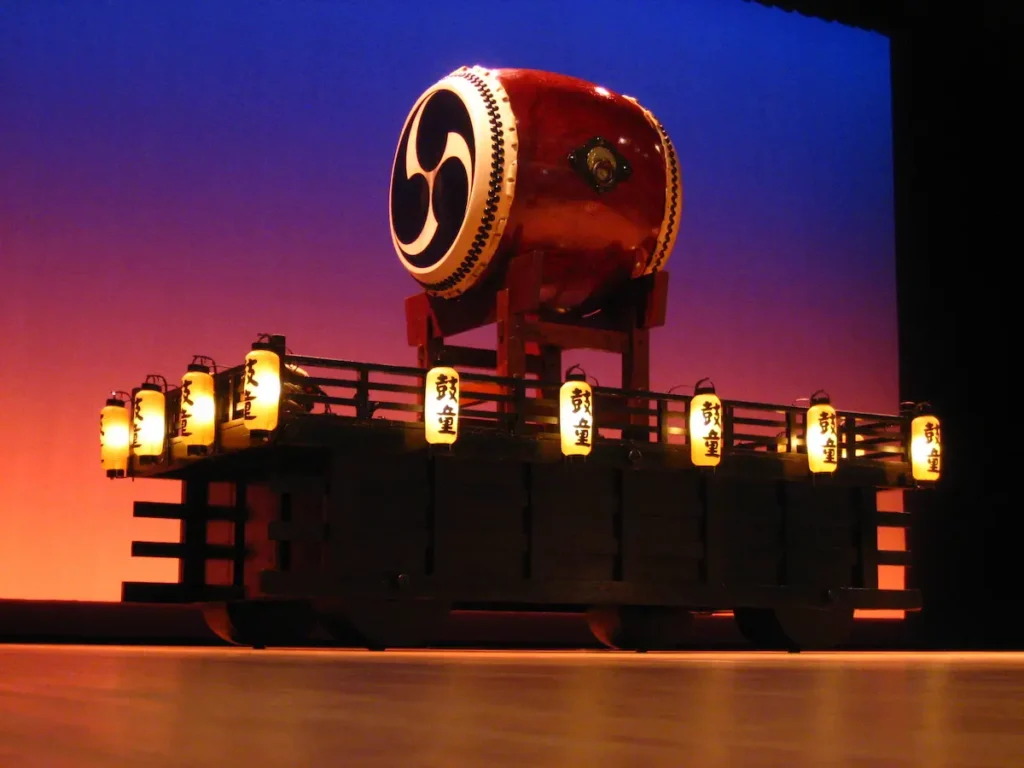
The Nagadō-daiko is a drum with a long body—it’s the most common type of drum you will see. It is further divided by sizes (from smallest to largest) into Ko-daiko. Chu-daiko, and O-daiko.
The shime daiko is very small and typically has a red or white cord that helps hold the head’s tension. The tsuzumi is a double-headed drum shaped like an hourglass and has a unique, table-like bend to the sound.
Each daiko plays different types of rhythms. For example, shime-daiko typically play rhythmically complex patterns, while the larger instruments perform compelling ostinatos. Also, like Gamelan, you can hear strings, vocals, and woodwinds along with the drums.
Tuning
Taiko tuning is a complicated process. Some drums are tuned with belts, while other instruments have the heads nailed on. The drum with heads held on by tacks/nails can only be adjusted once. Once they are hammered back on, the new drum head is set in place.
Famous Taiko Players
Some famous taiko drummers and groups include:
- Seidō Kobayashi
- Eitetsu Hayashi
- Kodō
Seidō Kobayashi is a member of a Toyko taiko group called Oedo Sukeroku Taiko, which is considered the first pro taiko group. Kobayashi is considered a taiko master. Eitetsu Hayashi is from Hiroshima and is best known for his solo taiko work. Some of his collaborative projects can be heard here. He was previously involved with the group Ondekoza and is a current member of Kodō.
Kodō
One of the most popular taiko groups is called Kodō. They travel worldwide and are one of the first professional taiko ensembles to take the ensemble abroad and popularize it. Kodō began in the early 1980s when they toured in Berlin, Germany. The Japanese word Kodō means both ‘heartbeat.’ Kodō’s mantra is “One Earth,” meaning that music has no bounds.
Take a listen to one of the ensemble’s riveting performances below.
Taiko Styles
While many taiko groups stay true to the original, a version of modern taiko developed in California blends Latin American percussion and Jazz with traditional taiko. The piece Gendai was written in the late 1970s: an excellent example of this fusion. San Jose Taiko learned this style while in San Francisco and is the group most known for this subgenre.
Where Can You Hear Taiko?
You can hear taiko in many locations in the United States! Taiko didn’t start becoming popular worldwide until the 1950s-1960s. Now, you can listen to Taiko ensembles here in North America, South America, Europe, Australia, and Taiwan. Some Japanese programs have taiko, like ours, at The Univerity of Toledo. Buddhist temples often start Taiko groups, like the Senshin Buddhist temple in LA.
Taiko in Popular Culture
Taiko can be heard in Cirque Du Soleil acts and movies like Isle of Dog. There is also a top-rated taiko drumming video game called taiko no Tatsujin, made by Namco. It looks quite entertaining and can be played on the Nintendo Switch.
Conclusion
Taiko is an exciting blend of dance and martial arts, military history, and religion. If you need a new hobby and enjoy Japanese culture, check out some Taiko groups in your area!





